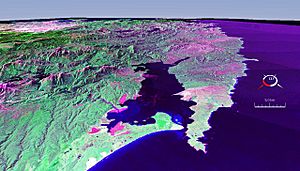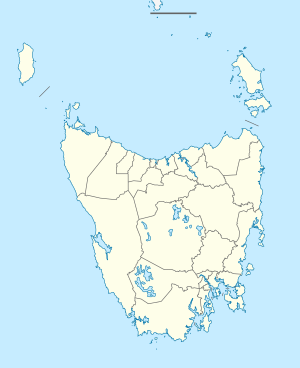Cape Sorell facts for kids
Quick facts for kids Cape Sorrell |
|
|---|---|

False colour Landsat image showing Macquarie Harbour with Cape Sorell in the centre right area of the picture.
|
|
| Location | West Coast, Tasmania, Australia |
| Coordinates | 42°11′24″S 145°09′36″E / 42.19000°S 145.16000°E |
| Geology | Cape |
Cape Sorell is a headland (a piece of land sticking out into the sea) on the west coast of Tasmania, Australia. It's located in the Southern Ocean, just outside Macquarie Harbour.
This cape is a very important landmark for ships. It helps them find their way into Macquarie Harbour through a narrow entrance called Hells Gates. The Cape Sorell Lighthouse on the cape also guides these vessels.
Cape Sorell was named after William Sorell. He was the Lieutenant-Governor of Tasmania from 1817 to 1824. The cape is often used as a marker for the northernmost part of the South West Tasmania region.
Cape Sorell Lighthouse
The Cape Sorell Lighthouse stands proudly on Cape Sorell. It was built in 1899 when mining was booming on the West Coast. This lighthouse is now a heritage-listed building.
You can find the lighthouse about 12 kilometres (7.5 miles) southwest of Strahan. It has been guiding ships safely for over a century.
Macquarie Heads Breakwater Railway
From 1900 to 1946, a special railway line existed near Cape Sorell. It was a horse-drawn wooden tramline. This line connected the Cape Sorell headland to the lighthouse and nearby jetties.
The railway was used to move rocks from quarries. These rocks were then used to build and maintain the breakwater at Macquarie Heads. A breakwater is a barrier that protects a harbour from strong waves.
Waverider Buoy: Captain Fathom
West of Cape Sorell, there's a special buoy called the Cape Sorell Waverider Buoy. It's also known as Captain Fathom. This name was chosen by listeners of ABC Radio, Tasmania in 2015.
The buoy's main job is to measure swell, which are large ocean waves. It helps scientists at the Bureau of Meteorology understand ocean conditions. The buoy is located about 10 kilometres (6.2 miles) west of Ocean Beach.


